Berastagi, Sumatra, Indonesia
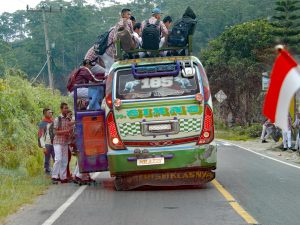 The trip to Berastagi is a bumpy, winding, vomit-smelling bus ride (children and old people puking out the windows behind me) lasting around 5 hours. We make a couple of stops for rests along the way and I get no less than 3 half-joking marriage offers from food vendors when they find out I am an American. We finally get to Berastagi and Ramona takes me to the guesthouse where he works, the Losmen Sibayak, and sets me up for the week.
The trip to Berastagi is a bumpy, winding, vomit-smelling bus ride (children and old people puking out the windows behind me) lasting around 5 hours. We make a couple of stops for rests along the way and I get no less than 3 half-joking marriage offers from food vendors when they find out I am an American. We finally get to Berastagi and Ramona takes me to the guesthouse where he works, the Losmen Sibayak, and sets me up for the week.
From the roof of Losmen Sibayak you can see the labyrinth of houses and shops of Berastagi, checkered with mismatched windows and colors, cement walls stained with age and water, and rusted tin covering every visible roof stretched out in the small, mostly one-road city. Huge satellite dishes that America abandoned in the early 90s dot almost every roof — among the only proof visible on the surface that this is among the wealthier cities in Sumatra. Agriculture brings the majority of the money instead of tourists, so being on your guard for scams is mostly unnecessary. Berastagi is nice.
On the way to Berastagi I notice a rash on my arm. Then I notice a rash on my shins. Then I notice a rash on my stomach. I have some wonderfully gruesome looking pictures of these but cannot upload them yet. They will come soon. A nice Chinese doctor gives some shots in the ass and some medication for it. He doesn’t speak english but writes down German Measles on a scrap of paper.
There is a restaurant in my guesthouse where I meet many travelers, most of whom are just in town for a couple days. One such traveler is a 50 year 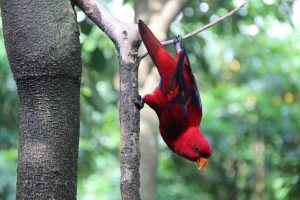 old British birdwatcher who is traveling through Indonesia for the sole purpose of birdwatching, so much so that he is clueless about many of the few tourist attractions when I mention them. I spend about three days with him in the strange world of “birdies” (what birdwatchers call themselves). Whenever we’re outdoors he stops in the middle of a sentence and grabs his binoculars if he sees a bird. The conversation is then lost as he has absolutely no memory of what he was talking about or why. He has a goal to see 5000 different birds in his lifetime, and he’s at 3800. He supposes he’ll take up plant watching when he’s done, never to travel again. It fascinates me. I don’t know if it’s a silly, useless preoccupation or one that perfectly mirrors the act of living: collecting and storing memories in your mind that never mean the same thing to anyone else but you. He doesn’t take pictures, just catalogs which ones he sees. He’d talk to me about different birds and the rare ones and the ones he wants most to see. We climb a volcano together, Gunung Sibayak. Again I have pictures of this, which are better than its description, but they must come later.
old British birdwatcher who is traveling through Indonesia for the sole purpose of birdwatching, so much so that he is clueless about many of the few tourist attractions when I mention them. I spend about three days with him in the strange world of “birdies” (what birdwatchers call themselves). Whenever we’re outdoors he stops in the middle of a sentence and grabs his binoculars if he sees a bird. The conversation is then lost as he has absolutely no memory of what he was talking about or why. He has a goal to see 5000 different birds in his lifetime, and he’s at 3800. He supposes he’ll take up plant watching when he’s done, never to travel again. It fascinates me. I don’t know if it’s a silly, useless preoccupation or one that perfectly mirrors the act of living: collecting and storing memories in your mind that never mean the same thing to anyone else but you. He doesn’t take pictures, just catalogs which ones he sees. He’d talk to me about different birds and the rare ones and the ones he wants most to see. We climb a volcano together, Gunung Sibayak. Again I have pictures of this, which are better than its description, but they must come later.
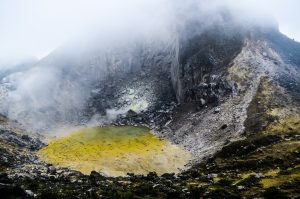 We had been warned to go up the easy side of the volcano and come back down that same side, as the “difficult” side was very hard to find without a guide. This was the one possible scam I came across in Berastagi; anybody who’s ventured a hundred paces and back into a wooded area could have found their way down the difficult side. The path ends behind a giant industrial plant, eventually coming out between two random houses.
We had been warned to go up the easy side of the volcano and come back down that same side, as the “difficult” side was very hard to find without a guide. This was the one possible scam I came across in Berastagi; anybody who’s ventured a hundred paces and back into a wooded area could have found their way down the difficult side. The path ends behind a giant industrial plant, eventually coming out between two random houses.
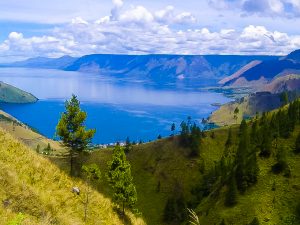 One of the guys who works in the kitchen of my guesthouse offers to take me down as a guide to Lake Toba, the biggest lake in Southeast Asia. It’s also where a lot of local families go on the weekend. He doesn’t get vacations so it would be somewhat of a holiday for him, and he doesn’t have much money so I’m paying for the ride, probably less than $10 for both of us round trip. We have a great time talking to families there and hanging out around the lake.
One of the guys who works in the kitchen of my guesthouse offers to take me down as a guide to Lake Toba, the biggest lake in Southeast Asia. It’s also where a lot of local families go on the weekend. He doesn’t get vacations so it would be somewhat of a holiday for him, and he doesn’t have much money so I’m paying for the ride, probably less than $10 for both of us round trip. We have a great time talking to families there and hanging out around the lake.
So why did I like Sumatra more than anywhere I’d been in Indonesia? Although I’d made meaningful relationships elsewhere with locals, it was extremely difficult to find such relationships in other locations as they are usually geared toward tourism and money. In Sumatra people are genuinely interested in you (especially if you’re traveling alone, AND are not married at the old age of 23. I’ve met guys here who have been married 3 times by that age). It’s much easier to say hello to a local in a cafe here and talk to him for an hour than it is anywhere else. And the scenery is absolutely spectacular. Beautiful jungle and unspoiled rivers are everywhere. Fruit is produced in abundance and shared freely over tea and coffee. I didn’t have to bargain once and I was always charged the local price (or at least very close to it) and public transportation was fantastic. Uncomfortable, yes, but for instance if the truck starts to speed off while I’m about to get off the other passengers grab hold of me to keep me from tumbling out the back (this happened twice). Everybody helps everybody unload their bags, and there’s little to no concern for theft because, well, there’s just not that much theft.
I’m going to publish more details of this time in North Sumatra in my first zine, No Conversation #1
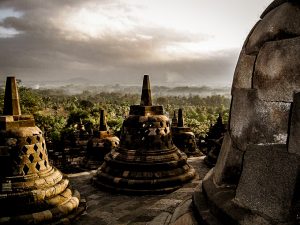 I go to Borobudur and Prambanan, Buddhist and Hindu temple ruins respectively. My tour left at 5am so we got to Borobudur at 6 and finished looking around by 8. It was nice and I have some good photos. Prambanan was more of a letdown: the reconstruction is not finished so it’s all fenced off and I only get to see bad pictures of the giant statues inside the buildings instead of going in.
I go to Borobudur and Prambanan, Buddhist and Hindu temple ruins respectively. My tour left at 5am so we got to Borobudur at 6 and finished looking around by 8. It was nice and I have some good photos. Prambanan was more of a letdown: the reconstruction is not finished so it’s all fenced off and I only get to see bad pictures of the giant statues inside the buildings instead of going in.
Originally published 30 August 2007

